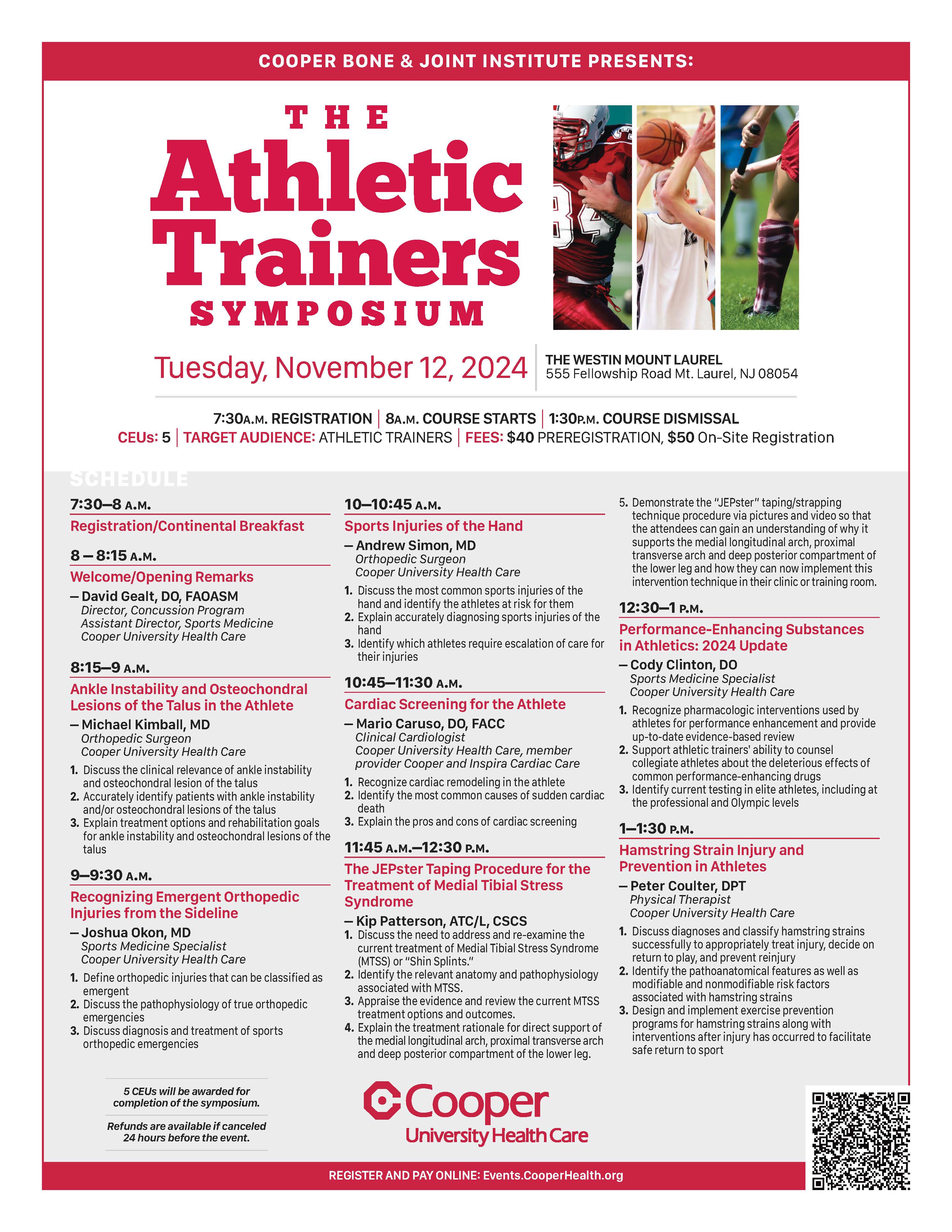2024 Athletic Trainers Symposium
Cooper Bone and Joint Institute is proud to sponsor the 2024 Athletic Trainers Symposium.
- Learn about the latest advances in athletic training.
- Network with other professionals in the field.
- Earn continuing education credits.
Our sports medicine specialists and a line-up of speakers makes this a can't miss event.

Cooper Bone & Joint Institute Presents: The Athletic Trainers Symposium
Tuesday, November 12, 2024
The Westin Mount Laurel
555 Fellowship Road Mt. Laurel, NJ 08054
7:30 A.M. Registration | 8 A.M. Course Starts | 1:30 P.M. Course Dismissal
CEUs: 5 | TARGET AUDIENCE: ATHLETIC TRAINERS | FEES: $40 PREREGISTRATION, $50 On-Site Registration
7:30–8 A.M.
Registration/Continental Breakfast
8 – 8:15 A.M.
Welcome/Opening Remarks – David Gealt, DO, FAOASM, Director, Concussion Program Assistant Director, Sports Medicine Cooper University Health Care
8:15–9 A.M.
Ankle Instability and Osteochondral Lesions of the Talus in the Athlete – Michael Kimball, MD, Orthopedic Surgeon Cooper University Health Care
- Discuss the clinical relevance of ankle instability and osteochondral lesion of the talus.
- Accurately identify patients with ankle instability and/or osteochondral lesions of the talus.
- Explain treatment options and rehabilitation goals for ankle instability and osteochondral lesions of the talus
9–9:30 A.M.
Recognizing Emergent Orthopedic Injuries from the Sideline – Joshua Okon, MD, Sports Medicine Specialist Cooper University Health Care
- Define orthopedic injuries that can be classified as emergent.
- Discuss the pathophysiology of true orthopedic emergencies.
- Discuss diagnosis and treatment of sports orthopedic emergencies
10–10:45 A.M.
Sports Injuries of the Hand – Andrew Simon, MD, Orthopedic Surgeon Cooper University Health Care
- Discuss the most common sports injuries of the hand and identify the athletes at risk for them.
- Explain accurately diagnosing sports injuries of the hand.
- Identify which athletes require escalation of care for their injuries
10:45–11:30 A.M.
Cardiac Screening for the Athlete – Mario Caruso, DO, FACC, Clinical Cardiologist Cooper University Health Care, member provider Cooper and Inspira Cardiac Care
- Recognize cardiac remodeling in the athlete.
- Identify the most common causes of sudden cardiac death.
- Explain the pros and cons of cardiac screening
11:45 A.M.–12:30 P.M.
The JEPster Taping Procedure for the Treatment of Medial Tibial Stress Syndrome – Kip Patterson, ATC/L, CSCS
- Discuss the need to address and re-examine the current treatment of Medial Tibial Stress Syndrome (MTSS) or “Shin Splints.”
- Identify the relevant anatomy and pathophysiology associated with MTSS.
- Appraise the evidence and review the current MTSS treatment options and outcomes.
- Explain the treatment rationale for direct support of the medial longitudinal arch, proximal transverse arch and deep posterior compartment of the lower leg.
- Demonstrate the “JEPster” taping/strapping technique procedure via pictures and video so that the attendees can gain an understanding of why it supports the medial longitudinal arch, proximal transverse arch and deep posterior compartment of the lower leg and how they can now implement this intervention technique in their clinic or training room.
12:30–1 P.M.
Performance-Enhancing Substances in Athletics: 2024 Update – Cody Clinton, DO, Sports Medicine Specialist Cooper University Health Care
- Recognize pharmacologic interventions used by athletes for performance enhancement and provide up-to-date evidence-based review.
- Support athletic trainers' ability to counsel collegiate athletes about the deleterious effects of common performance-enhancing drugs.
- Identify current testing in elite athletes, including at the professional and Olympic levels
1–1:30 P.M.
Hamstring Strain Injury and Prevention in Athletes – Peter Coulter, DPT, Physical Therapist Cooper University Health Care
- Discuss diagnoses and classify hamstring strains successfully to appropriately treat injury, decide on return to play, and prevent reinjury.
- Identify the pathoanatomical features as well as modifiable and nonmodifiable risk factors associated with hamstring strains.
- Design and implement exercise prevention programs for hamstring strains along with interventions after injury has occurred to facilitate safe return to sport
5 CEUs will be awarded for completion of the symposium. Refunds are available if canceled 24 hours before the event.
Upcoming Sessions
There are currently no upcoming sessions for this event


Reviews
There are currently no reviews posted for the event.